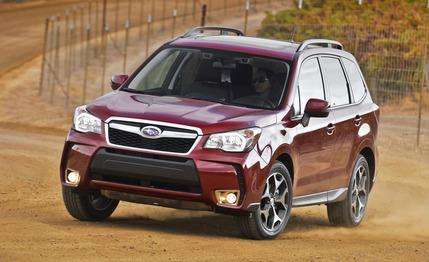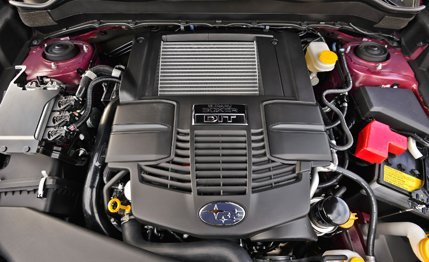 Prototype Drive
Prototype Drive
We will admit to having been so smitten by Subaru’s first-ever rear-drive performance coupe, the BRZ, that we haven’t paid much attention to the carmaker’s organically grown, high-fiber AWD wagons and crossover SUVs of late. It isn’t that we don’t have the occasional need for something suitably demure to take the golden retrievers to a quilters’ convention or retrieve a Victorian-era Ottoman for an installment of Antiques Roadshow. It’s just that the relationship had grown so cozy and familiar we’ve begun to take each other, you know, for granted.
Well, lace up your L.L. Bean Storm Chasers, because Subaru is introducing a new, fourth-generation Forester early next year as a 2014 model. Casual observers might not immediately notice what appears to be a nip here and a tuck there, but the Forester faithful—some 80,000 or so buyers annually in the U.S. alone—should be simpatico with the all-new sheetmetal. Adding a little testosterone is a blockier, more-SUV-like nose that’s an inch and a half taller—to meet pedestrian protection requirements—even though a squat boxer four still lives under that hood. A swept-back windshield and a gently arching roofline restore some caloric balance. Turbo models lose the WRX-inspired hood scoop, supplanted by a fluted and flared front fascia.

Bulking Up
We’ve commended the previous-generation Forester for its trim size, great sightlines, comfortable seats, and carlike agility, choosing the 2006 model as the top small SUV and a Car and Driver 5Best Trucks winner. For 2014, Subaru says it’s taking the Forester more mainstream, upsizing it slightly to play in the middle of the compact-crossover segment. Overall length increases by 1.4 inches, making it about two inches longer than the Honda CR-V and Mazda CX-5. Almost an inch is added to the wheelbase, as is 0.6 inch of width, upping shoulder room by almost an inch. Cargo space is up a claimed 12 percent. Sightlines don’t really suffer from the raised nose because the seats rise by 1.3 inches. Hiking the hemline also helps get some of the Forester’s all-wheel-drive business out of the way, allowing designers to lower the rear-seat floor-tunnel 2.7 inches, adding footroom. Despite the expansion, Subaru claims no increase in mass, thanks to, among other measures, more use of high-strength steel.
But what does the upsizing do to this small SUV’s fun-to-drive attributes, where bigger isn’t necessarily better? To help determine that, we sampled preproduction Foresters at Subaru’s test track hidden away in the mountains near Tochigi, Japan.
Like all automakers, Subaru tightens the screws on fuel economy for 2014 through improved aerodynamics (claiming the Cd drops from 0.37 to 0.33), reduced parasitic losses (electric power steering replaces hydraulic), and powertrain updates. The good news here is North American Foresters get a new direct-injected, turbocharged version of the naturally aspirated 2.0-liter boxer used in the BRZ; a six-speed manual replaces the moldy five-speed; and the Forester is finally rid of the four-speed automatic (soon to make its own appearance on Antiques Roadshow). The not-so-good news: That new six-speed manual can only be served with the base, carry-over, 170-hp, 2.5-liter boxer four; shiftless drivers get the fuel-stingy Lineartronic continuously variable automatic from the current Legacy. To its credit, this iteration of the CVT is largely free of whirring noises, due, according to Subaru, to a short-pitch chain. The CVT in the uplevel XT model we drove is equipped with Si Drive, which features three selectable shift modes (Intelligent, Sport, and Sport Sharp) and simulates up to eight paddle-selected ratios when in Sport Sharp mode.